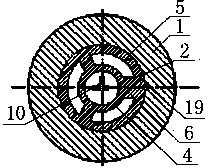[0003] The
longitudinal vibration of the drill string is carried out on the axis of the drill string. Its vibration is like the movement of heavy objects suspended at the lower end of the spring. It is mainly caused by the teeth alternately contacting the bottom of the well. It is different from the structure of the
drill bit, the nature of the formation, and the pump volume. It is related to factors such as uniformity, WOB and rotational speed. When the
longitudinal vibration is severe, the drill string will produce alternating tensile and compressive stress near the neutral point, which will easily lead to fatigue
fracture failure of the drill string at the neutral point, and may also cause damage to the
drill bit and damage to the drill string. Increased column wear and damage to ground equipment; drill string lateral vibration (also known as string vibration) vibrates like a string in a certain part of the drill string, mainly due to the
centrifugal force and the drill string during the rotation of the drill string. Caused by the collision with the well wall, especially when the drill string is bent by the
wellbore, it will intensify the
yaw, and the lateral vibration often causes the drill string to bear the alternating stress at the bend, resulting in the fatigue fracture of the drilling tool; the drill string
torsional vibration (also known as Spring shimmy) like the spring in the
clock drives the
balance wheel to twist repeatedly, mainly due to the intermittent-stick-slip motion of the bottom hole, the intermittent-stick-slip motion is mainly due to the
dry friction between the
bottom hole assembly and the rock As a result, the torsional movement will intensify the reversal of the drill string, generate alternating
shear stress, and shorten the service life of the drill string
[0004]
Drill string longitudinal, lateral,
torsional vibration and its
coupling vibration can easily lead to the actual performance of drilling tools such as drill string, drilling tools, and drill bits, thereby inducing major drilling accidents such as drill string fracture
For this reason, many scholars have analyzed the dynamic characteristics of the drill string through the drilling tool dynamics
analysis method, trying to use theoretical analysis to analyze the drill string vibration, in order to seek solutions to prevent drilling tool failure, scientifically control
wellbore trajectory, improve drilling efficiency, and reduce drilling costs. However, due to the complex interaction between the downhole drill string, the well wall and the bottom hole, it is difficult to obtain accurate results through
theoretical methods, and direct measurement is the most direct way to accurately obtain drill string vibration parameters or data
[0005] At present, the methods of measuring drill string vibration at home and abroad can be divided into
surface measurement method and downhole
measurement while drilling method. The
surface measurement method is mainly to install a triaxial acceleration sensor at the tap to measure the triaxial The vibration data is the result of the vibration of the downhole drill string being transmitted to the ground through the drilling tool. The vibration data obtained by this ground measurement is not real enough, and the collected
signal has obvious attenuation, and it is accompanied by a large number of
noise signals, especially In the case of
well drilling with complex structures such as inclined wells,
horizontal wells, extended-reach wells, and three-dimensional trajectory wells, the vibration data measured on the surface of the
wellhead (or near the
wellhead) basically loses its authenticity and practicability, and can only be used as an aid for decision-making The reference basis cannot be used as the most important basis for decision-making; the downhole
measurement while drilling method is mainly to install a triaxial acceleration sensor near the
drill bit to detect the
vibration acceleration of the drill string, and the measured vibration data can be transmitted through wired transmission, mud pulse or ultrasonic
waves. to the surface, it can also be stored in the downhole memory, and played back after the drill is pulled out. The data directly measured downhole, because it is near the drill bit, has higher accuracy than ground measurement and can more truly reflect the position near the drill bit. Actual vibration
At present, the schemes of devices or instruments for measuring downhole drill string vibration at home and abroad mainly use triaxial acceleration sensors (borehole Cartesian coordinates X / Y / Z axis) to measure drill string
vibration acceleration, and the acceleration measured by triaxial acceleration sensors The
signal can not monitor the lateral vibration and the torsional vibration parameters under the drill string vibration situation respectively, therefore, it is necessary to design the downhole drill string vibration monitoring device and method that can respectively measure the drill string longitudinal vibration, lateral vibration and torsional vibration parameters , so that technicians can better grasp the actual working conditions of the downhole drill string and drill bit
 Login to View More
Login to View More  Login to View More
Login to View More 


